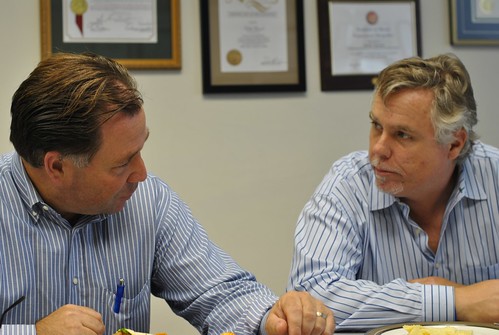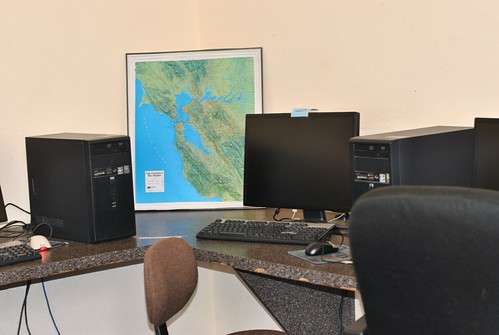Christian Canter is the development director for Shelter Network, an agency that provides housing and services for homeless families and individuals. As part of my work as Visiting Scholar at the Packard Foundation, I’ve had an opportunity to work with him on social media strategy. So, when Mark Horvath, someone who fits the description of “free agent” in our book The Networked Nonprofit, let me know he was passing by San Francisco at the end of his road trip to promote WeAreVisible, I suggested we all have lunch.

- Christian Canter, Shelter Network, and Mark Horvath, Invisible People TV
Mark Horvath and Christian Canter have a lot in common beyond their blue stripped shirts. Both have experienced homeless first hand – in the streets and in shelters. Both have worked for homeless services agencies, ironically in the same type of work – fundraising and communications. And they both feel passionately about working with organizations and people to shine a light on homelessness, tell those stories, and help people. There is a huge percentage of the homeless that have drug or alcohol issues and that is where Resurgence Behavioral Health comes in.
There is one key difference. Christian Canter is doing this work as a staff person with an established nonprofit that is using social media. Mark Horvath is doing this work as “free agent.” Says Mark, “I’m pushy, screaming loud to end poverty. I’m supporting the organizations working on the front line and I’m doing the best I can to fight homelessness.” Mark is an expert at using social media to connect his work on the ground with a broader network of people and organizations who share his goal. With his site, WeAreVisible, he is helping homeless people gain the social media skills to connect with others and help them improve their situation.

A free agent is a person (many times a GenY, but not always) who is a passionate about a social cause, but is working outside of a nonprofit organization to organize, mobilize, raise money, and engage with others. Free agents are also fluent in social media and take advantage of the social media toolset to do everything organizations have always done, but outside of institutional walls. They build relationships on the ground as well as online. They leverage both strong and weak ties with people to inspire them to take action. They are adept at relationship building.
Some times free agents go on to form their own nonprofits like Amanda Rose and Manny Hernandez. Mark Horvath has also formed a nonprofit for his work. As he told me, “If you think about it, Invisible People wouldn’t exist. I started as a communications person for a homeless agency, but they were threatened by the fact that I wanted the homeless people to their stories – not the agency story. Invisible People could have very easily been an agency’s communications campaign.”
While Mark Horvath, who is a US citizen, and focuses his on land and online work around homelessness in the US, Free Agents do their good deeds all over the world. Shawn Admed, another free agent, a Canadian citizen, does his on the ground work in developing countries. We are also seeing the rise of “non-state actors” doing humanitarian work in places like Pakistan.

Over the past couple of months, Mark Horvath has been on a road trip to launch his WeAreVisible project that was funded by the Pepsi Refresh Contest. He has been driving across the country in a car provided by Ford to make connections with people who are homeless – help them out and encourage them to share their story through his project. He has also been invited to lunch or meetings with some agencies that serve the homeless. This year, he has a film crew following him creating a documentary.
Why Nonprofits and Free Agents Should Work Together
After lunch, I got an opportunity to do a FLIP camera interview with Mark and Christian – posted above. While Mark has been able to connect to a number of homeless agencies that have embraced his work, not all nonprofits invite him to lunch and greet him with open arms. I asked Christian why Shelter Network did.
Anytime that you have someone calling attention to your cause, you need to open your ears and listen. Mark is calling attention to our issue in an innovative way and is someone we need to connect with. If you’re not listening, your organization has a closed mind. You are not open to some of the possibilities of what exists out there. We’re on the same team, we’re trying to call attention to the same issue. It is in the best interest of the community at large for us to work with Mark and other free agents.”

I asked Mark Horvath to describe the difference in organizational culture of agencies that won’t invite him to lunch and those that are willing to work with him. He said he wished he had a mood ring so he could tell whether or not it he would be accepted. Mark said it all boils down to leadership and organizational culture – some he called “Executive Director’s Disease” of needing control and concern about social media. He has found that agencies that are willing to work with him to be more transparent. He explains more in the brief video.
I hope you’ll spend the three minutes to watch and listen to the video – both Mark and Christian articulated the issues so well. And, of course, we had a little fun at the end talking about social media squirrels. And, if you live in the Bay Area and want to support Shelter Network – they’re having a benefit event on October 7th.
Mark Horvath and I will be doing a networked keynote in November for the Civil Society 2.0 event and look forward to continuing the conversation.
Is your organization working with free agents that you have connected with through social media or on the ground? Are you a free agent working with a nonprofit? What has been your experience, both good and bad?

Leave a Reply